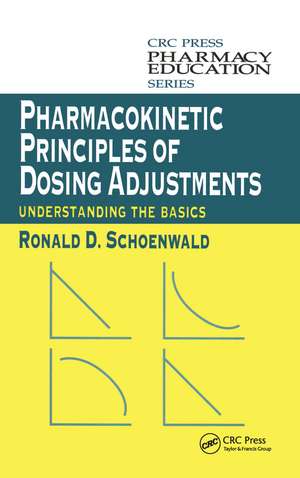Pharmacokinetic Principles of Dosing Adjustments: Understanding the Basics: Pharmacy Education Series
Autor Ronald D. Schoenwalden Limba Engleză Paperback – 30 noi 2000
Although many handbooks are available on this subject, they do not devote more than a brief chapter to the concepts behind the dosing adjustment approach. Pharmacokinetic Principles of Dosing Adjustments provides the concepts used to formulate approaches. Equations that appear in various chapters are developed, not through lengthy derivations, but by more of an intuitive approach. The equations are presented in their conceptual form, rather than a separate convenient form applicable to each clinic situation. This method is used to demonstrate how you can apply the initial conditions to the properties of the drug, patient and/or route of administration, rather than memorizing each variation of the basic equation. The author defines pertinent pharmacokinetic terms as well as kinetic processes and classical modeling relevant to dosing adjustments. Examples are included within each chapter that emphasize an understanding of the concepts.
Pharmacokinetic Principles of Dosing Adjustments was written for practitioners who operate in a setting that requires careful consideration to dosing parameters and, in particular, with patients that require constant monitoring of therapeutic outcomes including dosing adjustments. Based on the introductory course in pharmacokinetics taught by Dr. Schoenwald for the past twenty years, this book is intended as a review and resource for practicing pharmacists.
Din seria Pharmacy Education Series
- 18%
 Preț: 1335.31 lei
Preț: 1335.31 lei - 18%
 Preț: 898.21 lei
Preț: 898.21 lei - 15%
 Preț: 536.91 lei
Preț: 536.91 lei - 5%
 Preț: 1158.84 lei
Preț: 1158.84 lei -
 Preț: 466.96 lei
Preț: 466.96 lei - 5%
 Preț: 620.15 lei
Preț: 620.15 lei - 18%
 Preț: 1341.98 lei
Preț: 1341.98 lei - 18%
 Preț: 800.09 lei
Preț: 800.09 lei - 18%
 Preț: 1021.04 lei
Preț: 1021.04 lei - 15%
 Preț: 577.68 lei
Preț: 577.68 lei - 18%
 Preț: 1281.24 lei
Preț: 1281.24 lei - 15%
 Preț: 467.88 lei
Preț: 467.88 lei - 28%
 Preț: 1635.57 lei
Preț: 1635.57 lei - 29%
 Preț: 573.38 lei
Preț: 573.38 lei - 10%
 Preț: 336.18 lei
Preț: 336.18 lei
Preț: 623.56 lei
Preț vechi: 838.16 lei
-26% Nou
Puncte Express: 935
Preț estimativ în valută:
119.33€ • 129.58$ • 100.24£
119.33€ • 129.58$ • 100.24£
Comandă specială
Livrare economică 02-16 aprilie
Doresc să fiu notificat când acest titlu va fi disponibil:
Se trimite...
Preluare comenzi: 021 569.72.76
Specificații
ISBN-13: 9781566768993
ISBN-10: 1566768993
Pagini: 270
Dimensiuni: 152 x 229 x 17 mm
Greutate: 0.37 kg
Ediția:1
Editura: Taylor & Francis
Colecția Routledge
Seria Pharmacy Education Series
Locul publicării:Oxford, United Kingdom
ISBN-10: 1566768993
Pagini: 270
Dimensiuni: 152 x 229 x 17 mm
Greutate: 0.37 kg
Ediția:1
Editura: Taylor & Francis
Colecția Routledge
Seria Pharmacy Education Series
Locul publicării:Oxford, United Kingdom
Public țintă
Academic and ProfessionalCuprins
BASIC CONCEPTS. Pharmacokinetic Processes. Kinetic Processes Applied to the Whole Body. Disposition Parameters of the One-Compartment Model. Parameters Used In Adjusting Doses. PARENTERAL DOSING ADJUSTMENTS. Infusion. ORAL DOSING. Important Parameters. Bioavailability/Bioequivalence. Multiple Dosing Regimens. ADVANCED CONSIDERATIONS. Two-Compartment Model. An Introduction to Nonlinear Pharmacokinetics. Appendix: Study Guide Solutions.
Recenzii
"...introductory text... With its concise presentation and user-friendly examples, this text would best be utilized in introductory pharmocokinetics courses at the undergraduate level. It would also be a valuable addition to the reference collection of any medical library or drug information center."
-American Journal of Pharmaceutical Education, vol. 65, Fall 2001
-American Journal of Pharmaceutical Education, vol. 65, Fall 2001
Descriere
This book explains the basic concepts necessary for adjusting dosing regimens, presents equations in a conceptual manner, and describes the steps required to adjust dosages when the recommended manufacturer's dose is inadequate. The equations are developed, not through lengthy derivations, but by taking an intuitive approach. They are presented in their conceptual form, rather than a separate convenient form applicable to each clinic situation. The author defines pertinent pharmacokinetic terms, kinetic processes, and classical modeling relevant to dosing adjustments. Examples are included that emphasize an understanding of the concepts.
